Filtered By: Lifestyle
Lifestyle
A visit to Olango Island, vital wetlands and bird sanctuary
Text and photos by RIE TAKUMI, GMA News

Olango Island's mangroves and wetlands support hundreds of species of fauna, including 48 species of migratory birds for whom the island is a vital rest stop when they travel south for the winter.
A half-hour boat ride from Mactan and an hour's from Bohol, the island of Olango may seem underdeveloped, especially for an island aiming to draw in tourists. But what it lacks in infrastructure it makes up for in natural beauty.
The island's resources, after all, support 97 species of indigenous birds as well as 48 migratory species for whom Olango is a vital rest stop on the east-Asia migratory flyway to Australia. Thousands of birds, including endangered ones, make Olango their temporary home on their journey south for the winter.
Because of this, the island is a wildlife sanctuary, though low tide makes bird-watching a more difficult exercise in which you have to squint through a lone, long-range telescope to see any. And that is what I did last Saturday—despite its being World Migratory Bird Day that day, the birds were sparse throughout the island's sandy, mangrove-peppered wetlands.
The pathway to the bird-watching platform, however, is still special even when water is low in the basin.
It consists of flat concrete blocks set high enough that you can walk on them during high tide. Mudskippers and other fish crowd around the blocks, and at the beginning of the path are live shells clustered in colony-like formations.
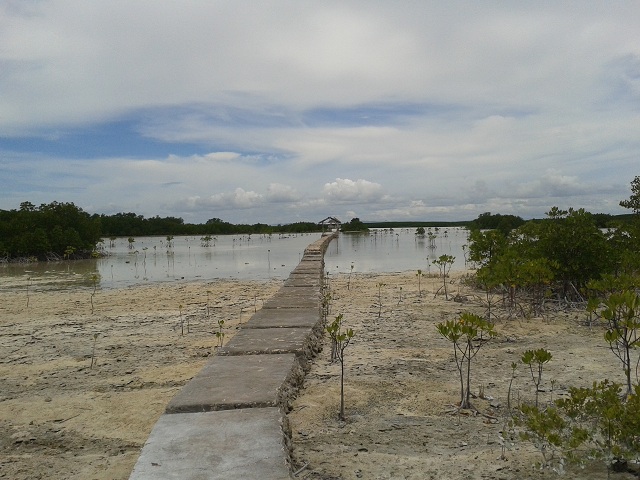
The island's resources, after all, support 97 species of indigenous birds as well as 48 migratory species for whom Olango is a vital rest stop on the east-Asia migratory flyway to Australia. Thousands of birds, including endangered ones, make Olango their temporary home on their journey south for the winter.
Because of this, the island is a wildlife sanctuary, though low tide makes bird-watching a more difficult exercise in which you have to squint through a lone, long-range telescope to see any. And that is what I did last Saturday—despite its being World Migratory Bird Day that day, the birds were sparse throughout the island's sandy, mangrove-peppered wetlands.
The pathway to the bird-watching platform, however, is still special even when water is low in the basin.
It consists of flat concrete blocks set high enough that you can walk on them during high tide. Mudskippers and other fish crowd around the blocks, and at the beginning of the path are live shells clustered in colony-like formations.

Mudskippers and shells cluster along the concrete steps to the bird-watching platform.
While there wasn't a whole rainbow of migratory birds when we were there, local bird species could be seen in the trees.
It's hard not to wax poetic over the fauna of Olango, considering it is literally everywhere, wild and domesticated. If you take a tricycle around the six-kilometer-long, three-kilometer-wide island, you will see goats, dogs, the occasional cow and the rare horse inhabiting the grassy knolls between houses.
Dogs also roam the rocky river paths. During a boat-paddling session with local volunteer group Olango Island Ecotour, we saw two dogs bounding through mangrove thickets to cool off.
The mangroves
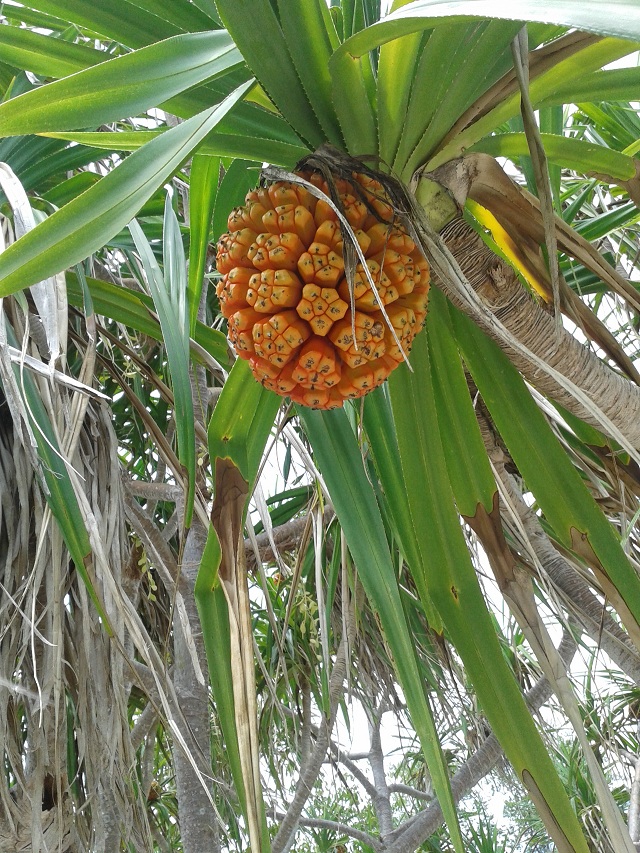 While the wetlands of Olango are naturally occurring—and named a Ramsar Site by the international Ramsar Convention on Wetlands in 1994—the coral beds along the mangrove path are man-made, constructed using materials like tires and concrete and only visible if your paddle boat crashes into them.
While the wetlands of Olango are naturally occurring—and named a Ramsar Site by the international Ramsar Convention on Wetlands in 1994—the coral beds along the mangrove path are man-made, constructed using materials like tires and concrete and only visible if your paddle boat crashes into them.
This is probably a good time to say that paddling in low tide, in trousers no less, is not a thing you should do. Instead, we walked on the path, with our guide picking mangrove seedlings on the way.
Most of Olango's mangroves are of the genus rhizophora, the most common type of mangrove in the world. They're easy to propagate, since seedlings only need to go brown before planting, but their long growing time means you will see only three feet of tiny stalks in two years.
Other types of bakan (mangroves) on Olango include the batisi (pemphis acidula), the kulasi (lumnitzera racemosa), and the banti or pandan, which has fruit that looks remarkably like a young pineapple.
The people of Olango
The Olango Island Group is under the jurisdiction of Lapu-Lapu City and has a population exceeding 20,000. The main island has eight barangays—San Vicente, Sabang, Sta. Rosa, Caw-oy, Baring, Talima, Tingo and Tungasan—and was named a protected wildlife sanctuary in 1992 via Presidential Decree 903. Olango has two other island barangays, Pangan-an and Caohagan.
The entire island celebrates its fiesta season every May, with each barangay celebrating on alternating weeks.
Not all of the livelihoods on the island revolve around conservation. Olango Island Ecotours is one of the Skills Training Development Support grantees under the "Improving Competitiveness in Tourism" project of the Department of Tourism, the Asian Development Bank, and the government of Canada.
It received the grant under the stipulation that 80 percent of its trainees should be women. Since the group was already mostly composed of women, it was only a matter of picking volunteers who had the weekends free.
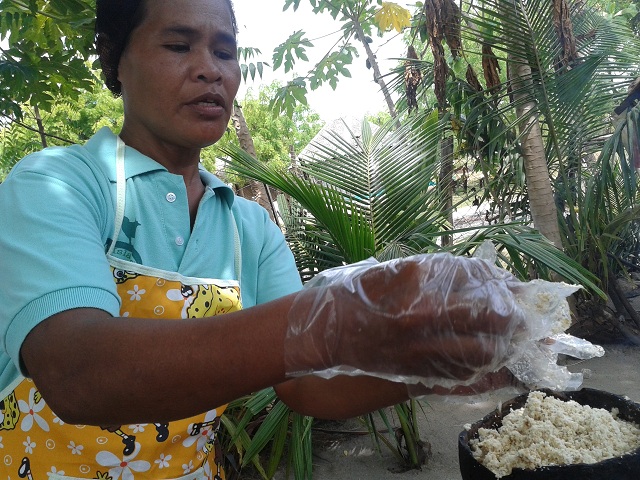
It's hard not to wax poetic over the fauna of Olango, considering it is literally everywhere, wild and domesticated. If you take a tricycle around the six-kilometer-long, three-kilometer-wide island, you will see goats, dogs, the occasional cow and the rare horse inhabiting the grassy knolls between houses.
Dogs also roam the rocky river paths. During a boat-paddling session with local volunteer group Olango Island Ecotour, we saw two dogs bounding through mangrove thickets to cool off.
The mangroves

The fruit of the banti, one of the many species of mangrove on Olango.
This is probably a good time to say that paddling in low tide, in trousers no less, is not a thing you should do. Instead, we walked on the path, with our guide picking mangrove seedlings on the way.
Most of Olango's mangroves are of the genus rhizophora, the most common type of mangrove in the world. They're easy to propagate, since seedlings only need to go brown before planting, but their long growing time means you will see only three feet of tiny stalks in two years.
Other types of bakan (mangroves) on Olango include the batisi (pemphis acidula), the kulasi (lumnitzera racemosa), and the banti or pandan, which has fruit that looks remarkably like a young pineapple.
The people of Olango
The Olango Island Group is under the jurisdiction of Lapu-Lapu City and has a population exceeding 20,000. The main island has eight barangays—San Vicente, Sabang, Sta. Rosa, Caw-oy, Baring, Talima, Tingo and Tungasan—and was named a protected wildlife sanctuary in 1992 via Presidential Decree 903. Olango has two other island barangays, Pangan-an and Caohagan.
The entire island celebrates its fiesta season every May, with each barangay celebrating on alternating weeks.
Not all of the livelihoods on the island revolve around conservation. Olango Island Ecotours is one of the Skills Training Development Support grantees under the "Improving Competitiveness in Tourism" project of the Department of Tourism, the Asian Development Bank, and the government of Canada.
It received the grant under the stipulation that 80 percent of its trainees should be women. Since the group was already mostly composed of women, it was only a matter of picking volunteers who had the weekends free.

A woman makes a cassava cake by hand. The cassava is ground, then placed in a bag and weighted down by a stone to squeeze out the juice. The dried-out remains are sifted and either cooked plain in a coconut-husk oven or mixed with muscovado sugar and coconut scrapings.
One of the demos performed during the tour was a cassava cake-making demo. Though the process is unique and the product delicious, what really made it interesting was the fact that only women were involved in the actual making of the pastries.
Another was a showcase of tools and ways fishermen worked the waters surrounding Olango. A small "boat" housed their catch, caught by harpoons or by traps and lures set up as early as dawn.
Some of the catch from a fishing trip the morning of our tour made its way to our dining table at noon. And it tasted every bit like the sea, with the exception of the chicken, which was probably the same chicken I saw in our dining garden an hour before lunch.
The food is unbelievably great—which is why I found it confounding when Ecotours president Mervil Patigdas said their grant was for food preparation, perhaps due to comments by former tourists to tour agencies.
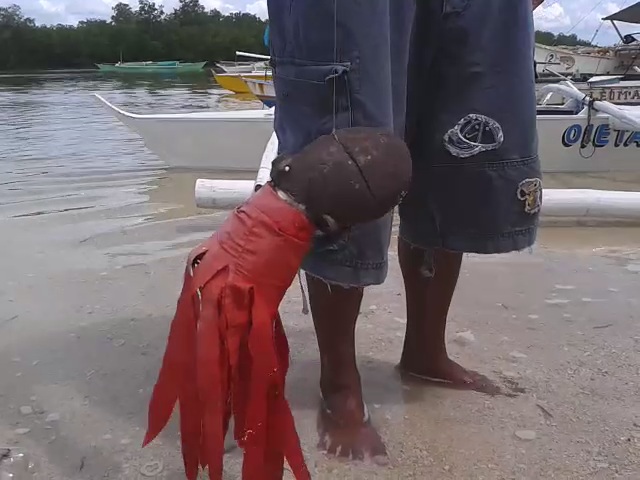
Another was a showcase of tools and ways fishermen worked the waters surrounding Olango. A small "boat" housed their catch, caught by harpoons or by traps and lures set up as early as dawn.
Some of the catch from a fishing trip the morning of our tour made its way to our dining table at noon. And it tasted every bit like the sea, with the exception of the chicken, which was probably the same chicken I saw in our dining garden an hour before lunch.
The food is unbelievably great—which is why I found it confounding when Ecotours president Mervil Patigdas said their grant was for food preparation, perhaps due to comments by former tourists to tour agencies.

An Olango fisherman dangles an octopus lure during the fishing demonstration. The fishermen use a variety of equipment, including a tube for catching eel, a basket for trapping fish, and foot paddles to swim with.
I truly think that food preparation is the least of the group's worries. Hygiene, as my brief experience with their plumbing can attest, is quite high on their list of priorities. The food itself is already prepared cleanly without compromising its freshness or taste. If anything is added to it, it runs the risk of ruining its authenticity.
Tourism as a whole is more than welcome to the island, but like in every other destination, the presence of tourists can also sometimes make hermitism seem like a great choice in life. More than the tourists, whose trash could easily be picked out of corals and water courses, foreign guides seem to cause greater distress to locals.
Mang Alex, the tricycle driver who happily chatted with me as he ferried my group around the island, said local guides often ended up being little more than photographers for tour groups. Instead of letting them, who knew the island better, perform their job, foreign guides would lead the groups and even bar well-meaning tourists from giving tips to any server they encounter.
Beyond the confines of the island, Olango residents who work as masseurs in nearby hotels are also getting the short end of the stick. Instead of getting base salaries, Mang Alex, said their salary was completely commission-based, "Kapag wala kang kliyente, 'di ka susweldohan," he said.
It's all hearsay until proven by other sources, but what Mang Alex said did almost dampen the trip. If Olango manages to garner more attention from outsiders—and I really hope that it does—would it be a good thing for the locals? Would the wild, empty spaces fill with tourist infrastructure, and would the simply prepared food be replaced with something not as authentic?
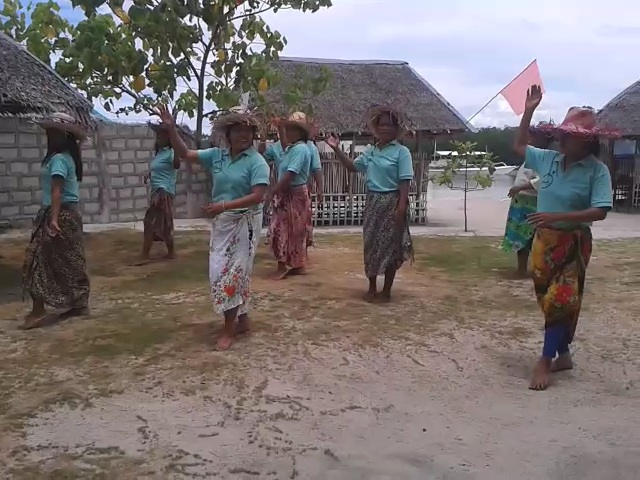
Tourism as a whole is more than welcome to the island, but like in every other destination, the presence of tourists can also sometimes make hermitism seem like a great choice in life. More than the tourists, whose trash could easily be picked out of corals and water courses, foreign guides seem to cause greater distress to locals.
Mang Alex, the tricycle driver who happily chatted with me as he ferried my group around the island, said local guides often ended up being little more than photographers for tour groups. Instead of letting them, who knew the island better, perform their job, foreign guides would lead the groups and even bar well-meaning tourists from giving tips to any server they encounter.
Beyond the confines of the island, Olango residents who work as masseurs in nearby hotels are also getting the short end of the stick. Instead of getting base salaries, Mang Alex, said their salary was completely commission-based, "Kapag wala kang kliyente, 'di ka susweldohan," he said.
It's all hearsay until proven by other sources, but what Mang Alex said did almost dampen the trip. If Olango manages to garner more attention from outsiders—and I really hope that it does—would it be a good thing for the locals? Would the wild, empty spaces fill with tourist infrastructure, and would the simply prepared food be replaced with something not as authentic?

The women of volunteer group Olango Island Ecotours perform their farewell dance.
Despite my worries, I wouldn't hesitate going to Olango again. I've always been a city girl, but coming to the island did not feel like a trip, but a homecoming. Personally, I think it's the preservation of this vibe, and not the presentation of their food, that the residents should be trained for. Infrastructure may change, food may adapt, but it's the warmth of the people and the vital importance of Olango's natural resources that could never be returned once lost. — BM, GMA News
More Videos
Most Popular



